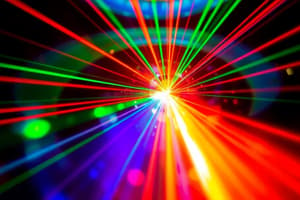Podcast
Questions and Answers
What does LASER stand for?
What does LASER stand for?
Light Amplification by Stimulated Emission of Radiation
The MASER amplifies electromagnetic radiation in the visible portion of the electromagnetic spectrum.
The MASER amplifies electromagnetic radiation in the visible portion of the electromagnetic spectrum.
False (B)
What is the name of the first laser, which was demonstrated in 1960?
What is the name of the first laser, which was demonstrated in 1960?
T.H. Maiman
What can be used to amplify and generate electromagnetic radiation in the MASER?
What can be used to amplify and generate electromagnetic radiation in the MASER?
Laser light is highly directional.
Laser light is highly directional.
What is the unit of measurement for the wavelength of light?
What is the unit of measurement for the wavelength of light?
Which of the following is NOT a property of laser light?
Which of the following is NOT a property of laser light?
The intensity of a laser beam is very high.
The intensity of a laser beam is very high.
A laser beam is strictly monochromatic, meaning it only contains a single frequency.
A laser beam is strictly monochromatic, meaning it only contains a single frequency.
The coherence of a laser beam is low.
The coherence of a laser beam is low.
What are the two types of coherence?
What are the two types of coherence?
The coherence length of a He-Ne laser is about 600 km.
The coherence length of a He-Ne laser is about 600 km.
Ordinary light spreads in all directions.
Ordinary light spreads in all directions.
How is the angular spread of a laser beam related to the diameter of the aperture and the wavelength of the light?
How is the angular spread of a laser beam related to the diameter of the aperture and the wavelength of the light?
What is the term that describes a condition where there is a large number of atoms in a higher energy state compared to a lower energy state?
What is the term that describes a condition where there is a large number of atoms in a higher energy state compared to a lower energy state?
What are the three main components of a laser?
What are the three main components of a laser?
In normal conditions, the number of atoms in the lower energy state is greater than the number of atoms in the upper excited state.
In normal conditions, the number of atoms in the lower energy state is greater than the number of atoms in the upper excited state.
What is the main function of the optical resonator?
What is the main function of the optical resonator?
What are the three key phenomena that occur when electromagnetic radiation interacts with the energy levels of atoms?
What are the three key phenomena that occur when electromagnetic radiation interacts with the energy levels of atoms?
Explain the process of stimulated absorption.
Explain the process of stimulated absorption.
What is the difference between spontaneous emission and stimulated emission?
What is the difference between spontaneous emission and stimulated emission?
Laser action can be achieved under thermal equilibrium.
Laser action can be achieved under thermal equilibrium.
What is population inversion?
What is population inversion?
Which of the following is NOT a method for achieving population inversion in a laser?
Which of the following is NOT a method for achieving population inversion in a laser?
The most common way to achieve population inversion is through optical pumping.
The most common way to achieve population inversion is through optical pumping.
In the electrical discharge method, electrons are accelerated using a magnetic field.
In the electrical discharge method, electrons are accelerated using a magnetic field.
What is the role of an active medium in a laser?
What is the role of an active medium in a laser?
Why is the active centre important during laser operation?
Why is the active centre important during laser operation?
A 100% reflecting mirror and a partially reflecting mirror are part of the optical resonator.
A 100% reflecting mirror and a partially reflecting mirror are part of the optical resonator.
What is the purpose of an optical resonator?
What is the purpose of an optical resonator?
What are the two main categories of solid-state lasers?
What are the two main categories of solid-state lasers?
What is the advantage of using a 4-level laser over a 3-level laser?
What is the advantage of using a 4-level laser over a 3-level laser?
Which type of laser is used widely in fiber optic communications?
Which type of laser is used widely in fiber optic communications?
A high refractive index for a material can act as an optical resonator in a semiconductor laser.
A high refractive index for a material can act as an optical resonator in a semiconductor laser.
What is the main advantage of using a gas laser over a solid-state laser?
What is the main advantage of using a gas laser over a solid-state laser?
What is the main application of lasers in electronic industry?
What is the main application of lasers in electronic industry?
What is the main difference between a pulsed laser and a continuous wave laser?
What is the main difference between a pulsed laser and a continuous wave laser?
What is the principle of holography?
What is the principle of holography?
Holography is used only for creating artistic displays.
Holography is used only for creating artistic displays.
Flashcards
Data Model
Data Model
A system that defines the format, structure, and interpretation of data.
Data Instance
Data Instance
A specific instance of data conforming to a data model.
Data Governance
Data Governance
A set of rules and procedures that govern the use and management of data.
Data Quality Management
Data Quality Management
Signup and view all the flashcards
Data Literacy
Data Literacy
Signup and view all the flashcards
Database
Database
Signup and view all the flashcards
Database Management System (DBMS)
Database Management System (DBMS)
Signup and view all the flashcards
Relational Database
Relational Database
Signup and view all the flashcards
Multi-User Database
Multi-User Database
Signup and view all the flashcards
Distributed Database
Distributed Database
Signup and view all the flashcards
Hierarchical Database
Hierarchical Database
Signup and view all the flashcards
Graph Database
Graph Database
Signup and view all the flashcards
Document Database
Document Database
Signup and view all the flashcards
Key-Value Store
Key-Value Store
Signup and view all the flashcards
Time-Series Database
Time-Series Database
Signup and view all the flashcards
Data Preparation
Data Preparation
Signup and view all the flashcards
Data Analysis
Data Analysis
Signup and view all the flashcards
Data-Driven Decision Making
Data-Driven Decision Making
Signup and view all the flashcards
Data Mining
Data Mining
Signup and view all the flashcards
Data Innovation
Data Innovation
Signup and view all the flashcards
Study Notes
Laser Introduction
- Laser is an acronym for Light Amplification by Stimulated Emission of Radiation
- Stimulated emission amplifies light waves
- Lasers produce a highly focused, intense, monochromatic beam
- No other light source compares to its ability to concentrate energy into a narrow beam
Albert Einstein's Prediction
- In 1917, Albert Einstein predicted two types of emission processes in atoms: spontaneous and stimulated
- Spontaneous emission occurs randomly while stimulated emission amplifies existing light
MASER Development
- In 1950, Schawlow-Townes (USA) and Basov-Prokhorov (USSR) developed MASER (Microwave Amplification by Stimulated Emission of Radiation)
- This technology used stimulated emission to amplify microwaves
Laser Development
- Following MASER, efforts focused on extending the amplification to optical frequencies.
- In 1960, T.H. Maiman demonstrated the first laser (using ruby)
- This led to rapid advancements in laser technology across various materials (glasses, solids, liquids, etc.)
Electromagnetic Spectrum
- Electromagnetic radiation exists in different forms within a range of frequencies and wavelengths.
- Lasers operate in the optical region of the spectrum, which includes visible light.
Interaction with Matter
- Atoms and molecules have specific energy levels
- Electrons can occupy discrete energy levels
- Light interacts with matter, affecting its energy levels, either by absorption or emission
- Absorption promotes electrons to higher energy states while stimulated emission causes electrons to return to lower energy levels emitting light
Laser Scheme
- Key components of a laser include: an amplifying medium, a pumping mechanism, and an optical resonator
- Amplifying medium, consists of atoms, molecules, or ions, which enhance light waves
- The pumping method furnishes energy to the medium, leading to population inversion
- The optical resonator, typically a pair of reflecting mirrors, provides feedback to amplify light through reflections
Laser Beam Characteristics
- Directionality: Laser beams travel as parallel beams over long distances before spreading. This contrasts with ordinary light beams, which diverge
- Intensity: Lasers exhibit high intensity, containing a significant number of photons in a tightly focused beam.
- Monochromaticity: Lasers produce light at a single wavelength or with a very narrow spectrum range unlike ordinary light sources
- Coherence: Laser light waves maintain a consistent phase relationship along a given beam, creating coherent light. This contrasts with incoherent light from ordinary sources.
Studying That Suits You
Use AI to generate personalized quizzes and flashcards to suit your learning preferences.




